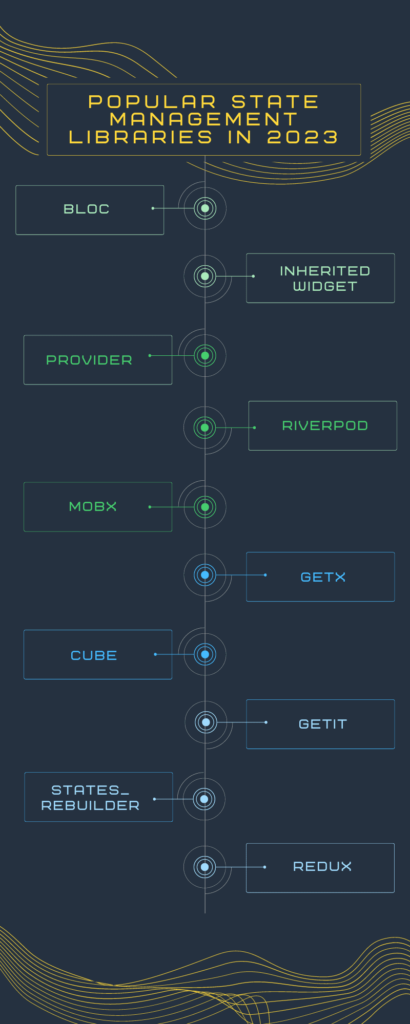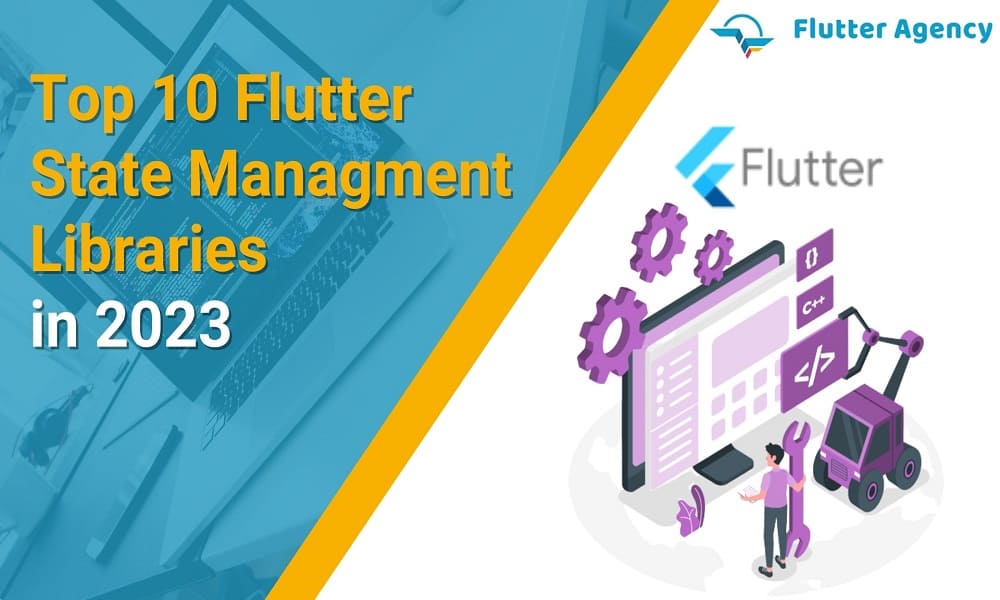Top 10 Flutter State Management Libraries in 2023
The Flutter framework allows the development of high-quality, high-performance apps on iOS and Android. Flutter is a Google UI portable UI toolkit to make mobile, web, and desktop applications using a single codebase. The best thing about Flutter is that it is free and open-source. Stateful and Stateless widgets are usually displayed with a toolkit. Still, it did not handle the state management or the architecture design as comprehensively as in comparison to the other frameworks.
However, a guidance of Flutter app state management is essential during the development phase of an application. Here, we have listed some of the top state management libraries that will be useful in your mobile application development project.
Flutter State Management
While developing the Flutter applications, state management is one of the vital aspects. It will track all the UI changes that a user made. Mobile, desktop, and web app management are dependent on it. Although, keeping the data and information in sync is easier with the Flutter state management library.
No matter what type of state changes are present, these libraries will make it easier to create and manage the apps. Developers will design the user interface from scratch using Flutter’s declarative programming style and update the app states as per the user interface. State management libraries are usually avoided while creating small apps without state transitions. The state management library is the better option while developing the complicated Flutter apps.
Also Read:
What’s Difference Between Ephemeral State & App State?
Benefits of State Management Libraries
Let’s see some of the benefits of the Flutter State Management Libraries, as its architecture has proven to be self-sustainable regarding state management.
1. Smooth Operation
These libraries will aid you in making apps that will enhance efficiency and handle data smoothly. It is directly interconnected with the user experience. It will also give you the precise performance of the features and functionalities of the application.
2. Business Logic
An application’s effectiveness is very low without a State management library. It will provide you with business logic with a server and database. However, an app user will find it more complicated and challenging as it does not use state management libraries.
3. Centralize Coding
It will minimize and maintain the long code base. It will ease Flutter developers to include quality code that is manageable and readable. However, they will quickly pick up code without much explanation.
Most Popular Flutter State Management Libraries in 2022
State management libraries in Flutter will make it easy to develop and manage the apps, whether it’s a type of state change. It returns a change of the app’s state as Flutter uses a declarative programming structure. Let’s see some of the following Flutter state management libraries in 2022.

1. BLoC
Google recommends the bloC pattern (Business Logic Component), which is the most well-known approach. The Bloc pattern will allow one to separate all the Flutter app’s logic into a single business Logic component.
Bloc is assigned to each screen in Flutter apps. We can also separate presentation code from business logic, making it easy to test and reuse. The developers will efficiently work on a similar code base using uniform patterns and conventions.
Combining BLoC with a reducer pattern is all about RXRx. A reducer is a function that will take a current state and actions as an argument and return the new result as a state.

2. Inherited Widget
Flutter gives the inherited widgets that will simplify state management. The inherited class enables other classes to access the data in the tree. Widgets are built to add interoperability to any of the applications. However, users can pass the state down by using the Inherited Widgets convenience class rather than having to type code in every child class. Using Inherited Widget in Flutter for the state transitions will not affect any of the widgets if it has a low level of the widget in the tree.
3. Provider
Provider packages are wrappers that are around the Inherited Widgets, which will make them easier to use and make them more reusable. An object of the widget tree is offered and is accessed internally by a provider class in the Bloc package. We can also use the Provider with Triple, ChangeNotifier, and various state objects.
Also Read:
Difference Between ChangeNotifierProvider & ChangeNotifierProvider.value
4. RiverPod
Riverpod is an implementation of the InheritedWidgets from scratch. However, during the development of the Provider, the author faces a few issues which are being eliminated in Riverpod.
Developers are facing several challenges while making use of Provider. Although, the Inherited widget is again integrated in a simple and easy-to-use way.
However, a Riverpod identifies the coding errors at a compile time. This unidirectional data flow will make the apps more scalable as it will make the app objects visible in Flutter’s devtool by default. It simplifies complicated object graphs and makes the patterns independent of Flutter apps.
5. MobX
It represents the simple way to connect reactive data to a user interface. MobX will work behind the scenes in many ways, which may sound simple, but one must have a basic idea about its concepts and terms. MobX is dependent on three concepts: Observables, Reactions, and Actions.
In MobX, the reactive data is usually connected to the UI via a state management library. However, being its automatic nature, this wiring feels very natural. UI developers can concentrate on the reactive data required to be consumed without worrying about these two things in sync.
6. GetX
GetX is the quick, stable, lightweight state management library for Flutter web apps. You can also do the dependency injection using GetX, a powerful and robust miniature framework. We can transfer the information internally in an application with the state management. Additionally, the app’s state is upgraded whenever the information is passed, hence rebuilding the applications.
7. Cube
Flutter’s cube library uses dependency injection without any code generation needs, which will make a list of the advanced state management libraries. It is easy to understand if you are new to the Flutter community. Besides that, it simplifies state management objectively and minimizes code difficulty by rebuilding the widget trees as required.
Cube is very intuitive, and it has gained popularity. Object-oriented state management is a focus of the apps. Hence, a widget tree is rebuilt only when needed, reducing the coding complexity.
8. GetIt
GetIt is the optional state management for the Provider or InheritedWidget. It is usually used to access the objects, but it is not the same as the state management technique. GetIt allows you to differentiate an interface from integration and concrete implementation.
9. States_Rebuilder
States_Rebuilder is the state management library that will focus on accomplishing four targets: Better performance, Clean Code, User-friendly architecture, and supports efficient production. It will also work by separating UI from business logic. It has a built-in dependency injection system, and it will support immutable and mutable states. An elegant syntax, the state manager, is sufficient for user authorization and authentication.
10. Redux
Redux will help to differentiate business and presentation logic, followed by the unidirectional data flow architecture. Developers will introduce UI changes and quickly detect errors and bugs. Redux is preferred for large applications and will synchronize solutions. Redux state management will make the state stable, making it quite effortless for programmers to find the bugs.
Conclusion
Choosing the Flutter state management library is essential in the development process. Hence an app developer does not need to spend too much time dealing with complicated code that uses simple state transitions. This list will provide the information you are looking for. At Flutter Agency, we use appropriate state management libraries as needed. Our developers will create Flutter apps to increase and enhance a business presence in the market. Let’s integrate and get in touch with us to create Flutter mobile applications.
More Resources:
- How to Set Up an Emulator For VSCode?
- Explore Flutter Bloc 8.0.1 Design Pattern in Flutter
- Beginners Guide: States in Flutter?
Frequently Asked Questions (FAQs)
1. Why do we need state management?
As we know, data is scattered everywhere without any use of state management. These state management libraries will give the facility one-way data flow in the apps. You must first know a concept before entering into the state management libraries like functional programming, RXJS, typeScript, and reactive programming.
2. Why do we use state management in Flutter?
State management is necessary for Flutter app development as it permits centralized UI state control and manages the data flow in the application.
3. What is the state management pattern?
State Management pattern is the pattern that will properly share the state data across the components and separates the domain representation from the state management. However, this pattern is being used by many popular web frameworks like Vuex, Flux, or Redux.
4. What is the approach to managing the state in Flutter applications?
State management is usually divided into two categories depending on the duration state that has been expressly stated lasts in an application. Ephemeral will exist for a few seconds, just like the current state of the animation or the single page, just like the current rating of the product. Flutter framework also supports a Stateful Widget.
5. What is the use of the application state?
Application state is utilized as the data repository that is available to all classes in the applications. An app state is stored in memory on the server, which is faster for storing and retrieving the data in the database.
Contemporary ventures
Recent blog
ready to get started?
Fill out the form below and we will be in touch soon!
"*" indicates required fields













